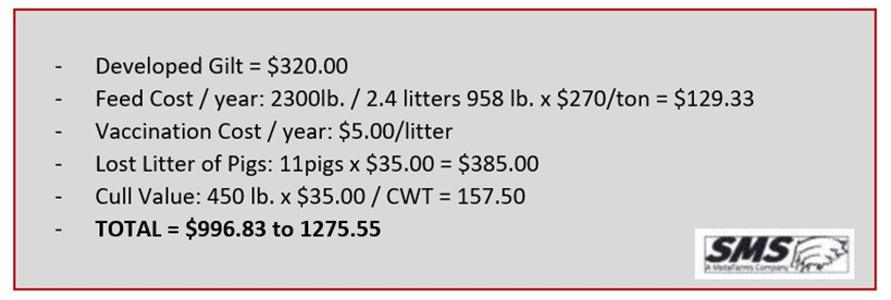



Genesus competitive edge: Prolapses
Genesus does not have a significant rate of prolapses. As you can see by information below the World’s Largest Swine Genetic Company has a list of reasons pointing at everything but Genetics. At Genesus we don’t have a list because we don’t have an issue. Maybe it is Genetics?
Dead sows don’t have pigs or salvage value. Swine Marketing Systems (SMS) estimates a dead sow is a financial loss of $996.83 to $1275.55. If you want to see if your terrible prolapse issue will go away – Try Genesus. Compare and Decide.
SMS Calculation of the Cost of a Dead Sow

PIC: February 2022: Prolapse mitigation tactics
PIC is continuously investigating all leads and will update and review all available data evaluating a potential genetic linkage with pelvic organ prolapse (POP). So far, no indication of a genetic role has been found, but we continuously refresh data and analyses.
Below includes a list of items that could contribute to rectal or pelvic organ prolapse. In addition to good practices that will favorably impact sow robustness, these factors may influence or reduce the rate of prolapse. However, we do not believe any of these items or their combination are the underlying reasons for spikes in industry prolapse trends across the Americas. We recognize that all farms are different, rate of success may vary.
Data indicates thin sows just prior to farrowing have elevated risk for POP.
Evaluate body condition before farrowing.
Calipers have proven to be a valuable aid to measure body condition objectively but other methods can be used. A suggested intervention point to evaluate feeding strategies further is greater than 10% thin sows at farrowing.
Make sure the gestation sow feeding program implementation is consistent.
Avoid sudden changes of body condition across gestation by feeding below base feeding level for extended periods of time. Most body condition adjustment in over conditioned herds will occur in the farrowing house.
PIC feeding recommendations:
- Feed gilts in their first gestation 5.9 Mcal ME/d (4.4 Mcal NE/d) or approximately 4.0 lb/d of a corn soy based diet regardless of body weight. Gilts bred heavy tend to also be the heavier at farrowing and lose more condition during lactation. Focus on the gilt development program to achieve the desired age and weight breeding targets.
- Sows in thin condition at any stage of gestation: 8.0 Mcal ME/d (6.1 Mcal NE/d) or approximately 5.5 lb/d of a corn soy based diet. Most thin sows should return to ideal condition within 30 days.
- Recognize sows with underlying medical conditions such as ulcers or lameness will not recover in 30 d if the medical condition is not addressed. Be prepared to separate thin sows in pens to individual housing if not recovering body condition.
- Prior to farrowing in the farrowing house: Continue feeding the same feed amount as sows were previously fed in gestation. Thus, thin sows will be fed above base level.
- For P2+ sows (third gestation+) during late gestation, when they are the heaviest and thus require more feed for maintenance, consider increasing the base feeding level by 0.75Mcal ME or 0.55Mcal NE/d(0.5 lb or 0.25 kg/d).
- Routinely adjust feed delivery to ensure the desired amount of feed is being delivered.
Ensure proper water availability to reduce constipation
- PIC research shows that 80% of females could be clinically dehydrated in late gestation. Fecal scoring data collected in Brazil indicate that sows with drier and hardened manure during peripartum period are higher risk for prolapse.
- Make sure water is available and accessible 24/7 in gestation and farrowing.
- Check water nipple flow as part of room set up.
- Confirm gilts entering farrowing crates for the first time are trained to waterers upon entry.
- Identify females that didn’t drink and eat the same day they are moved to farrowing. Do not wait until the day after.
- Use any type of treat to encourage exploration of water nipples.
- Make sure all females stand at least twice a day and touch water nipple to show them how and where to drink.
- Constipation typically is a result of dehydration. Laxatives alone will not solve the primary problem and the need for long time use is probably masking some other issues (poor water accessibility, availability and intake).
- Be cautious when using laxatives. Water intake must be met. Do not over-dose laxatives in feed and consider total amount if used in the diet and top dressing. The maximum dose for chemical laxatives is 30 g/d.
Strategic sow movement and Identifying risk populations
- Data indicates that females with perineal score 3 (PS3) have an elevated risk of prolapses.
- Identify PS3 females in late gestation (~100 days of gestation) mark them and place them together along with thin females when loading farrowing room to simplify their monitoring.
- Proactively ensure their water intake and ensure they defecate daily and walk them as needed.
- Make sure to follow up closely identifying at-risk populations at farrowing and assist them as needed during the farrowing process.
Optimum farrowing monitoring with minimum hormone use.
- The majority of prolapses happen around parturition. We encourage close monitoring to identify in a timely manner sows experiencing farrowing difficulty and assist them accordingly.
- Although data indicates that hormones usage has no evidence for influence on the risk of prolapse, we advise to minimize the use of oxytocin and support the farrowing process with natural Oxytocin release: Rubbing the udders and assure sow has piglets suckling on her teats during farrowing. Once 5 pigs have been born, never let sows nurse less than that number of pigs to provide natural oxytocin stimulation.
As much as the production flow and facilities allows, try to postpone any processing until the last sow of the room is done.








